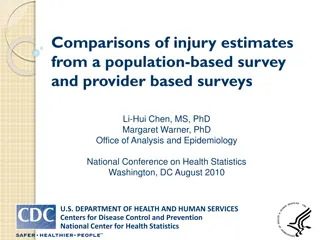Mastering the Art of Crafting Effective Survey Questions
Crafting good survey questions is essential for gathering accurate and meaningful data. Dr. Amy Moffat, PhD, provides valuable insights on key characteristics of survey questionnaires, best practices for asking survey questions, and how to avoid common pitfalls like double-barreled and biased questions. Learn the importance of clarity, consistency, and open-ended vs. close-ended questions to enhance the quality of your surveys.
Uploaded on Sep 22, 2024 | 0 Views
Download Presentation

Please find below an Image/Link to download the presentation.
The content on the website is provided AS IS for your information and personal use only. It may not be sold, licensed, or shared on other websites without obtaining consent from the author.If you encounter any issues during the download, it is possible that the publisher has removed the file from their server.
You are allowed to download the files provided on this website for personal or commercial use, subject to the condition that they are used lawfully. All files are the property of their respective owners.
The content on the website is provided AS IS for your information and personal use only. It may not be sold, licensed, or shared on other websites without obtaining consent from the author.
E N D
Presentation Transcript
+ HOW TO WRITE GOOD SURVEY QUESTIONS Amy Moffat, PhD
+Characteristics of a Survey Questionnaires Large number of respondents (if small number, better to do interviews) Either use probability or nonprobability sampling Systematic procedures are used to ask predetermined questions and record answers Answers are numerically coded and analyzed with aid of statistical software
+How to Ask Survey Questions CLARITY Questions should mean the same thing to every respondent 6thgrade reading level Short questions are best CONSISTENCY Keep directions the same, or as similar as possible Keep answers to positive/negative questions in same question (unless there is a good reason to mix it up) Cluster similar types of items together
+How to Ask Survey Questions OPEN-ENDED AND CLOSE-ENDED QUESTIONS Close-ended questions ensure uniformity, can be easier for the subject to answer, and can be easier to analyze Open-ended questions allow for more subtle responses and perhaps more precise measurement
+ISSUE: Double-barreled Avoid double-barreled questions, which are questions that force two sentiments to coexist Example: Please indicate how much you agree or disagree with each of the following statements about the childcare program. Incorrect: I feel welcomed by staff and other youth at the center Correction: I feel welcomed by staff at the center I feel welcomed by other youth at the center
+ISSUE: Biased / Leading questions Avoid biased questions Social desirability is a common problem Avoid associating an attitude or a position with a prestigious person or agency Include both positive and negative choices in the question Be aware of loaded terms Be aware of acquiescence which is when a respondent gives up and provides similar responses to similarly formatted question
+ISSUE: Biased / Leading questions Incorrect: Community organizing is hard. Do leadership trainings help you feel prepared for community organizing? Much more prepared Somewhat more prepared Slightly more prepared Not more prepared Correction: The leadership trainings prepare me for community organizing. Strongly agree Agree Disagree Strongly disagree
+ISSUE: Double negatives Avoid questions with double negatives It could be a negative statement containing two negative elements (didn't say nothing ). Or it could be a positive statement in which two negative elements are used to produce the positive force, usually for some particular rhetorical effect (there is not nothing to worry about! ). Incorrect Does it seem possible or does it seem impossible to you that the Nazi extermination of the Jews never happened? Very possible Possible Impossible Very impossible Correct Do you doubt that the Holocaust actually happened or not? Very possible Possible Impossible Very impossible
+ISSUE: Accessible Information Questions in a survey need to be answerable Avoid questions respondents may not know the answer to One option is to use a filter question SKIP patterns are very helpful Computerized surveys and questionnaires can be programmed so that respondents never see that questions have been skipped based on earlier responses.
+Example #1 More people have attended the movie, Gone with the Wind, than any other motion picture produced this century. Have you seen this movie? Yes No Problem? Biased / Leading Solution? Have you seen the movie Gone with the Wind? Yes No
+Example #2 In your opinion, how would you rate the speed and accuracy of your work? Excellent Good Fair Poor Problem? Double-barreled Solution? In your opinion, how would you rate the speed of your work? Excellent Good Fair Poor In your opinion, how would you rate the accuracy of your work? Excellent Good Fair Poor
+Example #3 Did you first hear about the bombing: ______ from a friend or relative ______ from a newspaper ______ from the television or radio or other electronic media ______ from your spouse ______ at work Problem? Categories are not mutually exclusive Solution? Did you first hear about the bombing: ____ from a friend ____ from a relative ____ from a media source
+Example #4 How do you feel about the following statement? We should not reduce military spending. Strongly agree Agree Disagree Strongly disagree Problem? Double Negative Solution? How do you feel about the following statement? We should reduce military spending. Strongly agree Agree Disagree Strongly disagree
+Example #5 Higher than single-family density is acceptable in order to make housing affordable. Strongly Agree Agree Undecided Disagree Strongly Disagree Problem? Ambiguous Solution? In order to make housing affordable, is it acceptable to build housing whose buildings hold more than one family? Strongly Agree Agree Undecided Disagree Strongly Disagree
+Example #6 People grow up in all different types of families. What type of family did you grow up in? ______Mom as single parent ______Dad as a single parent ______Both Mom and Dad Problem? Categories are not exhaustive Solution? People grow up in all types of families. What type of family did you grow up in? ____two biological parents ____one biological parent & a step parent ____ mom as a single parent ____ dad as a single parent ____ with a relative other than my biological parents ____ in foster care ____ with adoptive parent(s)























